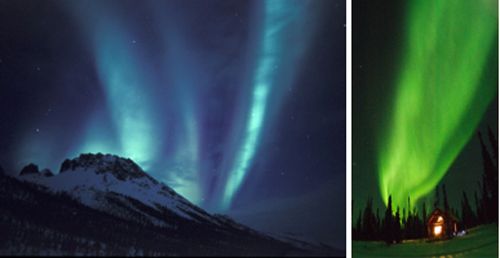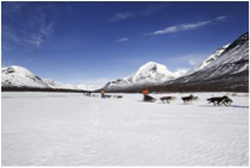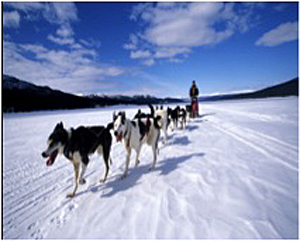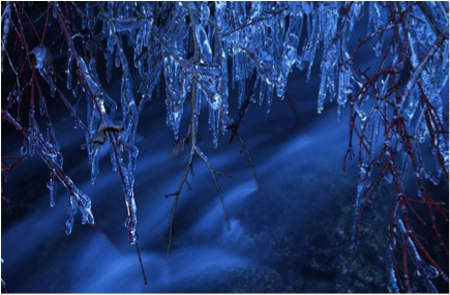
Steve noticed first. He'd left the tent to answer Nature's call, and from beyond the canvas flap we could hear his shouts. We threw thick coats over layers of long underwear, tugged on vapor-barrier boots, and tramped into the arctic night.
Looking up, a faint, green glow appeared in the northeast, upriver, in the direction of the North Pole. Then, very quickly, shafts of aquamarine light stabbed the sky. Howls rose from the dogs as the streaks split into bands and danced and fanned across the firmament. We were witnessing the visible chorus called Aurora borealis.
The lights built to a pulsing green, then flew into an electric fury of ten or more different colors, flashing in shifting rhythms. The whole of the sky filled with the hues and harmonies of the Northern Lights. I had to sit down in the snow to avoid vertigo.
For almost an hour the sky exploded in purples and reds, transformed greens to yellows. Then, at around 10:00 pm, during a brief lull, I fetched tripod and camera, anticipating the customary end to a splendid fireworks display, the Grand Finale. The sky darkened, making the silhouettes of the twin mountain masses of the Gates of the Arctic separate substance from the ethereal. I had the feeling of being inside some great fishbowl. A thin nebulous cloud of green appeared directly overhead and hovered, changing form every few seconds. Suddenly, the fishbowl was alive as flickering tongues of green licked the glass, and dancing flames encircled us, spreading upwards.
When the sky faded enough to permit us to wearily consider returning to the tent, I took off my glove and grabbed my tripod. My skin instantly stuck to the metal leg, and for the first time, as I ripped my hand away from the steel rod, leaving behind swatches of pink and red epidermis, I recognized how cold it was....40 degrees below zero.
Our little dogsledding outing began at the river village of Bettles, north of the Alaska Range, north of the Yukon, north of the Arctic Circle, north of almost everything on the planet. This is the site of the international, global headquarters for Sourdough Outfitters. From here we flew an M-6 Maule Stole single-engine ski plane even farther north to the frozen North Fork of the Koyukuk River, about 100 miles north of the Arctic Circle.
The first night was spent in a 15' x 18' white spruce cabin on a tributary called the Tinyaguk. It had no electricity, but a lantern gave off a warm glow, and a pot belly stove turned the space toasty, even though it was -15 degrees outside. Crack of noon next day, after feeding the dogs clumps of frozen white fish for breakfast, we began to mush in earnest, into the whiteness. My team included Creamo, Spooky, Zipper and Gus, all veterans of the Iditarod. It was a Polar Express as we glided over dry, powdery snow, the stony light of the sun on our necks, brittle wind snapping our noses, the scenery stunning as any Himalayan vista. Robert Marshall, founder of the Wilderness Society, called this region as beautiful as "a thousand Yosemites." The valley was ringed with silent, snow-shrouded peaks scribbling upwards from timberline, meshing with the white-on-white winter sky. Silence hung over the landscape like a cold smoke; there was only the rhythmic jingle of the harnesses, the squeaking of snow beneath the runners, the panting of the dogs, and my talent-manager friend Steve Marks singing Motown from the 60s.
We passed tracks of moose, lynx, caribou, and the star-patterns of the snowshoe hare; we slid past stands of cottonwood, willow and spruce, and sailed towards the famous granite spires known as Boreal Mountain and Frigid Crags, the guardians of the 600-mile-long Brooks Range, the Gates of the Arctic. The ice on the Koyukuk River, which splits the Gates, had become thin and watery with the day, so we had to turn back just shy of the twin peaks, not far from the northern-most tree line.  We paused first for photos in the shadow of the monument, commenting that somewhere in the world someone was complaining about the heat, and someone else griping about the crowds. Ken Jarkow, my accompanying friend from Manhattan, said he shared his building with 5,000 people, and there were 5000 other buildings within the distance we had traveled by dogsled that day. Even though the gage said -20, it seemed pleasantly comfortable to me after the hours of alternatively tugging the lead lines and stepping on the brakes, and I could think of no place I would rather be. We were, in likelihood, the only people in the entire 7.2 million-acre Gates of the Arctic National Park.
We paused first for photos in the shadow of the monument, commenting that somewhere in the world someone was complaining about the heat, and someone else griping about the crowds. Ken Jarkow, my accompanying friend from Manhattan, said he shared his building with 5,000 people, and there were 5000 other buildings within the distance we had traveled by dogsled that day. Even though the gage said -20, it seemed pleasantly comfortable to me after the hours of alternatively tugging the lead lines and stepping on the brakes, and I could think of no place I would rather be. We were, in likelihood, the only people in the entire 7.2 million-acre Gates of the Arctic National Park.
That night, camped in a heated Quonset hut tent, we dined on moose stew, moose ball spaghetti, and spicy reindeer sausage, washed down with swigs of Yukon Jack. No caloric or cholesterol worries here...the cold burns off all the fat during the day's activities. But as we dug into our puffy sleeping bags, wearing heavy gloves and skull caps to preserve body warmth, the temperature outside sank to -40 degrees. That's when the Northern Lights began to prance.
With the crisp of morning we fed the dogs, melted water for the canteens, and chopped wood to leave behind in the tent, a backcountry pay-it-forward courtesy so a tired musher drifting in during a snowstorm can start a fire without having to find his own fuel. Then, we saddled up and turned south, over the frozen back of the river, towards the turn-of-the-century mining outpost of Wiseman.
About midafternoon our south-bound slide ran into some trouble: Overflow. This is a section of river in which water has been squeezed to the surface through cracks in the ice as the heavy top snow and ice have settled. Sometimes this overflow water is quite deep--our guide says he once sledded through overflow up to his chest. We had, however, little choice but to continue our course in the river bed. Not a single maintained road or trail exists within the park, which is three times the size of Yellowstone. Regardless, the snow was too deep for the dogs to plow through beyond the river banks. So, cautiously, gingerly, we advanced over the ice and through the river-wide puddles. In places the water reached knee-depth, but by climbing on the sled frames we kept the water from flowing into our boots, and after a few challenging hours we were beyond the dreaded overflow and enroute to a warm stove and hot coffee.
The final night was in a tiny cabin, with a door so small we had to crawl through (designed to keep bears out, and warmth in). Nearby was a bubbling spring in the ice. I dipped my Sierra Club cup, and put to my lips the cleanest, clearest, coolest water in North America.
The final day was a 20-mile gambol through a southern spur of the Brooks Range, the Blue Cloud Mountains. These peaks provoked like strippers, teasing with veils of mist, sometimes revealing faces, shoulders and other parts; necks strung with glaciers, shards of white jewelry flashing. Maybe I was getting snow drunk in the cold, but I felt like leaving a tip. The last few miles rode like the downside of a coaster ride, careening into the Wiseman Valley, the dogs dialing up the speed, smelling home.
At dusk we pulled into Wiseman, dogsledding capital of the world, with a ratio of 30 dogs to every human. We then hotfooted it to nearby Coldfoot, mile 175 on the Dalton Highway, the 414-mile gravel road that runs from Fairbanks to Prudhoe Bay. Coldfoot is 60 miles north of the Arctic Circle, 240 miles below the Arctic Ocean, and shelters 13 permanent residents, and the best burgers in North Country.
In 1981, Dick Mackey, winner of the Iditarod dog race, began selling burgers out of a bus at Coldfoot, and they became a hit among the ice-road truckers. So, we stopped in for a world famous burger, a shower and a sleep at the truck stop, and the next day began the trek back to California, where everyone was crabbing about the cold.

